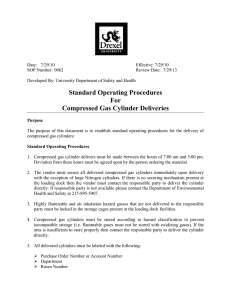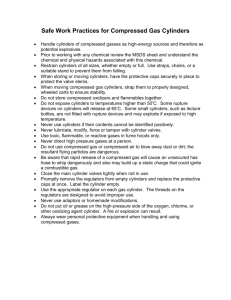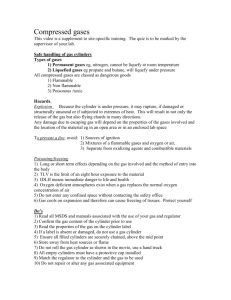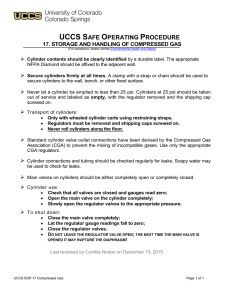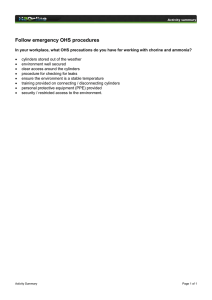Compressed Gas Cylinder Storage and Handling Overview
advertisement
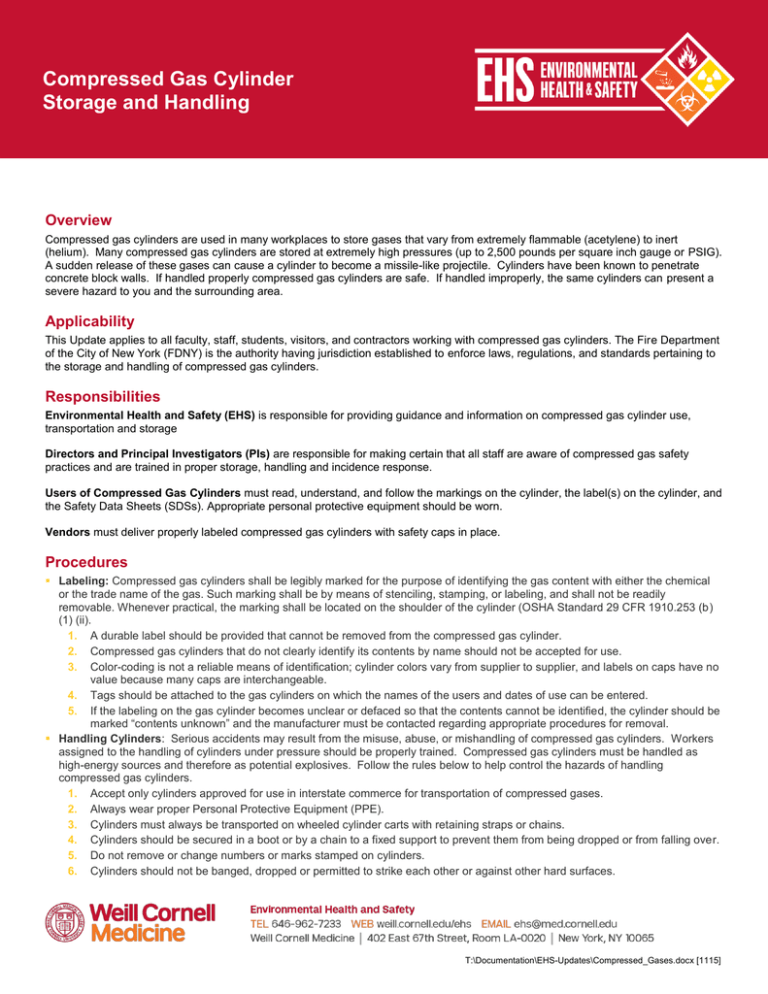
Compressed Gas Cylinder Storage and Handling Overview Compressed gas cylinders are used in many workplaces to store gases that vary from extremely flammable (acetylene) to inert (helium). Many compressed gas cylinders are stored at extremely high pressures (up to 2,500 pounds per square inch gauge or PSIG). A sudden release of these gases can cause a cylinder to become a missile-like projectile. Cylinders have been known to penetrate concrete block walls. If handled properly compressed gas cylinders are safe. If handled improperly, the same cylinders can present a severe hazard to you and the surrounding area. Applicability This Update applies to all faculty, staff, students, visitors, and contractors working with compressed gas cylinders. The Fire Department of the City of New York (FDNY) is the authority having jurisdiction established to enforce laws, regulations, and standards pertaining to the storage and handling of compressed gas cylinders. Responsibilities Environmental Health and Safety (EHS) is responsible for providing guidance and information on compressed gas cylinder use, transportation and storage Directors and Principal Investigators (PIs) are responsible for making certain that all staff are aware of compressed gas safety practices and are trained in proper storage, handling and incidence response. Users of Compressed Gas Cylinders must read, understand, and follow the markings on the cylinder, the label(s) on the cylinder, and the Safety Data Sheets (SDSs). Appropriate personal protective equipment should be worn. Vendors must deliver properly labeled compressed gas cylinders with safety caps in place. Procedures Labeling: Compressed gas cylinders shall be legibly marked for the purpose of identifying the gas content with either the chemical or the trade name of the gas. Such marking shall be by means of stenciling, stamping, or labeling, and shall not be readily removable. Whenever practical, the marking shall be located on the shoulder of the cylinder (OSHA Standard 29 CFR 1910.253 (b) (1) (ii). 1. A durable label should be provided that cannot be removed from the compressed gas cylinder. 2. Compressed gas cylinders that do not clearly identify its contents by name should not be accepted for use. 3. Color-coding is not a reliable means of identification; cylinder colors vary from supplier to supplier, and labels on caps have no value because many caps are interchangeable. 4. Tags should be attached to the gas cylinders on which the names of the users and dates of use can be entered. 5. If the labeling on the gas cylinder becomes unclear or defaced so that the contents cannot be identified, the cylinder should be marked “contents unknown” and the manufacturer must be contacted regarding appropriate procedures for removal. Handling Cylinders: Serious accidents may result from the misuse, abuse, or mishandling of compressed gas cylinders. Workers assigned to the handling of cylinders under pressure should be properly trained. Compressed gas cylinders must be handled as high-energy sources and therefore as potential explosives. Follow the rules below to help control the hazards of handling compressed gas cylinders. 1. Accept only cylinders approved for use in interstate commerce for transportation of compressed gases. 2. Always wear proper Personal Protective Equipment (PPE). 3. Cylinders must always be transported on wheeled cylinder carts with retaining straps or chains. 4. Cylinders should be secured in a boot or by a chain to a fixed support to prevent them from being dropped or from falling over. 5. Do not remove or change numbers or marks stamped on cylinders. 6. Cylinders should not be banged, dropped or permitted to strike each other or against other hard surfaces. T:\Documentation\EHS-Updates\Compressed_Gases.docx [1115] CONTINUED: Compressed Gas Cylinder Storage and Handling 7. Never use compressed gas to dust off clothing. This could cause injury to the eyes or body and create a fire hazard. Clothing can become saturated and burst into flames if touched by an ignition source such as a spark or open flame. 8. Do not use the valve cover to lift cylinders; they could be damaged and become unattached causing the cylinder to drop on a hard surface, possibly resulting in an explosion. Storage: The rules listed below will minimize hazards when storing compressed gas cylinders. Please see figures 1.1 – 1.4 for examples of proper compressed gas cylinder storage. Figure 1.1 Figure 1.2 Proper Compressed Gas Cylinder storage in a laboratory, secured in a rack. Proper Compressed Gas Cylinder Storage in a Laboratory, secured by straps. 1. 2. 3. 4. 5. 6. 7. 8. 9. 10. 11. 12. 13. 14. 15. 16. 17. Figure 1.3 Proper Compressed Gas Cylinder Storage at a Construction Site, secured by chain. Figure 1.4 Proper Compress Gas Cylinder Storage, secured by chain. Store cylinders upright and secure them with a chain, strap, or cable to a stationary building support (i.e. Structural Beam) or to a cylinder cart to prevent cylinders from tipping or falling. Liquefied flammable gas cylinders should be stored in an upright position, or such that the pressure relief valve is allowed to remain in the gas phase. Cylinders loaded with liquefied gas are not completely filled; a small vapor space is left to allow for expansion if the cylinder is heated. Use only approved containers to store and transport liquid nitrogen. Containers should have vented lids to prevent spillage when carried. Compressed gas containers must be separated from each other based on the hazard class of their contents. Combustible waste must be kept a minimum of 10 feet from the compressed gas containers and systems. Oxygen cylinders should be kept at a minimum of 20 feet away from flammable gases, liquids, solids, greases and oils. Flammable gas indoor storage of 3,500 SCF (99.12 m3) or less must be located not less than: 20 feet (6096 mm) from all classes of flammable and combustible liquids, oxidizing gases and readily combustible materials, such as paper and combustible fibers. 25 feet (7620 mm) from open flames, ordinary electrical equipment or other sources of ignition. 50 feet (15 240 mm) from air-conditioning equipment, air compressors and intakes of ventilation. 50 feet (15 240 mm) from other flammable gas storage. Store cylinders in a dry, well-ventilated area away from flames, sparks, or any source of heat or ignition. Mark cylinder storage areas with proper precautionary signs, such as “Storage of flammable, oxidizer, or toxic materials.” Place cylinders in a location where they will not be subject to mechanical or physical damage, heat, or electrical circuits to prevent possible explosion or fire. Segregate empty cylinders from full cylinders. Caps used for valve protection should be kept on the cylinders at all times, except when the cylinder is actually being used or charged. Cylinder valves should remain closed. Never plug, remove, or tamper with any pressure relief device. Under normal conditions, these containers will periodically vent the product. Cylinders should not be exposed to an open flame or to any temperature above 125 degrees Fahrenheit. Cylinders should not be exposed to continuous dampness, stored near salt or other corrosive chemicals or fumes. Corrosion may damage cylinders and cause their valve protection caps to stick. When empty cylinders are to be returned to the vendor, mark them “Empty” or “MT.” In non-laboratory areas, a FDNY permit is required for storing, handling or using compressed gases in excess of the amounts listed on next page. 2 CONTINUED: Compressed Gas Cylinder Storage and Handling TABLE 105.6(1) PERMIT AMOUNTS FOR COMPRESSED GASES Type of Gas Amount (SCF) Corrosive 400 Flammable 400 Highly toxic Any Amount Nonflammable and non-oxidizing, except carbon dioxide 3,000 Carbon dioxide 4,500 Oxidizing 504 Pyrophoric Any Amount Toxic Any Amount Unstable (reactive) Any Amount Water reactive Any Amount 18. The FDNY sets storage limits on the amount of gases that may be stored in a laboratory. The storage limits are based on the square foot of the lab: LABORATORY CONSTRUCTED UNDER OLD NYC FIRE CODE: Flammable Gas Storage Limits Area of Laboratory in square Per additional Up to 500 sq. ft. Maximum per Laboratory Unit feet 100 sq. ft. Maximum Capacity in cubic feet (water container 9.24 1.54 15.4 capacity) LABORATORY CONSTRUCTED UNDER OLD NYC FIRE CODE: Gases Storage Limits Up to 500 sq. ft. (ft3) Per additional Gas Types 100 sq. ft. (ft3) Flammable 12.0 2.4 Oxidizing 12.0 2.4 Liquid flammable 2.4 0.36 Health hazard 3 or 4 0.3 0.06 Transporting: 1. Cylinders transported by wheeled truck must be fastened securely in an upright position so that they will not fall or strike each other (see figure 2.1 for an example). 2. Cylinders should not be transported without safety caps. A cylinder’s cap should be screwed all the way down on the cylinder’s neck ring and should fit securely. Do not lift cylinders by the cap. The cap is for valve protection only. 3. Cylinders should not be transported with the regulator attached to the cylinder. 4. Always use a cylinder cart to move compressed gas cylinders. Refrain from sliding, dragging, or rolling cylinders on their edge. 5. Only one cylinder should be handled (moved) at a time. 6. If the cylinder is to be shipped by an interstate carrier, it must have a D.O.T. label. Personal Protective Equipment (PPE): Avoid Skin Contact. When handling gases that are harmful to the skin, protective gloves and/or aprons must be worn to prevent skin absorption. Choose clothing made of materials that resist Figure 2.1 Proper Compressed Gas Cylinder Transportation 3 CONTINUED: Compressed Gas Cylinder Storage and Handling penetration or damage by the compressed gas. Refer the compressed gas cylinder’s SDS for recommendations pertaining to PPE. If the information is not provided on the SDS, contact the supplier for specific information. Protect Your Eyes and Face. Workers should wear safety goggles/glasses when handling and using compressed gases. In some cases, a face shield should be worn. Types of Hazards: Physical Damage: Cylinders are very hazardous when exposed to damage from falling over, tipping, heat, electric circuits, motion, vibration, or anything that can cause a weakness or crack in the cylinder wall or shell. Such damage can cause the cylinder to rupture and explode sending sharp metal pieces, like shrapnel, blasting through the area. Tipping and Falling: The most common hazard associated with cylinders occurs when cylinders tip or fall over. Since cylinders are heavy and awkward to handle, they require special care and equipment in handling and securing so they do not fall or tip over and cause injury. Valve Leakage: Cylinder valves can leak, causing their contents to discharge. To minimize hazards from leaks, use proper ventilation and storage. Definitions Combustible Material: Any liquid, solid mixture, substance, or compound that emits a flammable vapor at temperatures between 100 degrees Fahrenheit and 300 degrees Fahrenheit when tested in a Tagliabue open cup tester (E.g. fuel oil). Compressed Gas: A material in a container with an absolute pressure greater than 276 kilopascals (kPa), or 40 psi (pounds per square inch) at 21 degrees Celsius or an absolute pressure greater than 717 kPa (104 psi) at 54 degrees Celsius, or both, or any liquid flammable material having a Reid vapor pressure greater than 276 kPa (40 psi) at 38 degrees Celsius. D.O.T.: Department of Transportation; oversees federal highway, air, railroad, and maritime and other transportation functions. Fire: A chemical reaction known as combustion. It involves the rapid oxidation of a combustible material and the release of energy in the form of heat and light. Oxygen, heat, and fuel in proper proportions create a fire. Flammable Gas: Flammable gases may be ignited when mixed with air in certain concentrations (i.e., acetylene, methane, hydrogen). Ignition Source: For a flammable gas within its flammable limits (or oxidizing gas to ignite), an ignition source must be present. There are many possible ignition sources including open flames, sparks, and hot surfaces. Safety Data Sheet (SDS, formally Material Safety Data Sheets or MSDSs): The safety data sheet (SDS) for a given material is provided by its manufacturer. It contains specific information about the health and physical hazards of the material. It also lists the protective equipment required when handling the material. The safety data sheet describes the material’s physical characteristics and the procedures that should be followed in the case of an emergency. PSI: A measurement unit used by the FDNY when describing the pressure of a gas inside a cylinder. The letters PSI stand for pounds per square inch. References Occupational Safety and Health Administration, 29 CFR 1910.101 – Compressed gases (general requirements) Occupational Safety and Health Administration, 29 CFR 1910.253 – Oxygen-fuel gas welding and cutting Department of Transportation (DOT), 49 CFR 173.301 – General requirements for shipment of compressed gases and other hazardous materials in cylinders, UN pressure receptacles and spherical pressure vessels. New York City Fire Department Fire Code, Chapter 30: Compressed Gases Compressed Gas Association (CGA) 4
